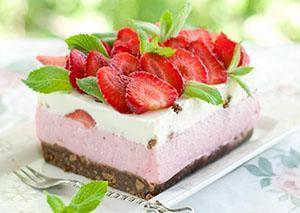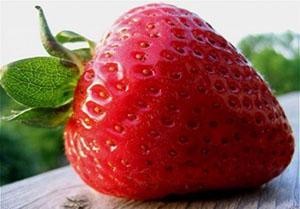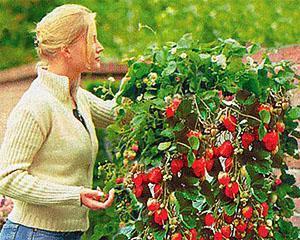Garden strawberry - royal berry
 Strawberries or strawberries are a very aromatic, sweet and sour, soft and juicy berry. No wonder it is called royal. It is consumed not only fresh. Strawberries are the main component of many desserts, compotes; compotes, juices, and preserves are made from it. This berry is added to baked goods and fruit salads. In any case, the usefulness of strawberries is preserved, and the taste remains almost unchanged. Garden strawberries have unique properties. It contains a lot of substances necessary for the body, vitamins.
Strawberries or strawberries are a very aromatic, sweet and sour, soft and juicy berry. No wonder it is called royal. It is consumed not only fresh. Strawberries are the main component of many desserts, compotes; compotes, juices, and preserves are made from it. This berry is added to baked goods and fruit salads. In any case, the usefulness of strawberries is preserved, and the taste remains almost unchanged. Garden strawberries have unique properties. It contains a lot of substances necessary for the body, vitamins.
Garden strawberries, varieties of different ripening periods
Many gardeners enjoy growing strawberries, although this is not an easy task. The berry requires proper planting and careful care. Fortunately, many varieties of garden strawberries are known today, and everyone can choose the most suitable one.
The berries that ripen before anyone else include varieties such as:
- Dawn. One of the most productive varieties, but does not tolerate frost, heat and drought. The plant has many mustaches.
- Kokinskaya early. Differs in "amicable" ripening of berries.
- Early Macherauch. German variety. It has high winter hardiness, its only enemy is gray rot.
- Junia Smides. Latvian variety, moderately resistant to frost and disease. The first berries are large, the rest are smaller.
The varieties of medium ripening include the following:
- Knight. Possesses high winter hardiness. Rarely suffers from fungal diseases and ticks.
- Zenith. The variety is considered the most resistant to diseases such as wilt and powdery mildew.
- The beauty of Zagorja is also not susceptible to diseases.
- Hope. The variety reacts quite steadily to thaws in winter.
- Sudarushka. It tolerates winter normally, almost not afraid of gray rot.
- Troitskaya. The plant has tasty berries, hardy.
- Festivalnaya. The first berries of this strawberry weigh up to 46 grams, the next ones - 10 grams. It tolerates winter normally.
 Festival chamomile. The berries of this variety are smaller, but the yield is quite high. The plant is almost not affected by gray mold.
Festival chamomile. The berries of this variety are smaller, but the yield is quite high. The plant is almost not affected by gray mold.- Relay race. This strawberry variety is resistant to many diseases, is almost not afraid of pests and is famous for its good yield.
Those who need late ripening varieties choose the following:
- Zenga Zengana. Has a taste and aroma of wild strawberry, is distinguished by good transportability. The plant recovers well after freezing the soil.
- Cinderella. Drought tolerant and winter tolerant.
- Red Gauntlet. This Scottish variety does not like spring frosts, and is quite resistant to diseases and strawberry mites.
- Mascot. The enemy of this variety is the spider mite. He also does not tolerate winter very well.
There are also curly strawberry varieties. Raosta climbing strawberries, for example. This variety can be grown vertically, on supports or in special containers. It is also distinguished by long-term fruiting - the crop can be harvested from early summer to early autumn!
Place for strawberries (strawberries) garden
 Basically, strawberries are planted on a flat surface. It is advisable to choose the beds located in the southwest. However, steep slopes, beds on the southern sides and cold lowlands should be avoided. In such places, the harvest will be small. As for the soil, then a moist soil with a pH of 5.5-6.5 should be chosen for this plant. Saline, clayey, sandy, limestone, acidic and too wet types of soil are not suitable for him.The swampy area is also not suitable for strawberries.
Basically, strawberries are planted on a flat surface. It is advisable to choose the beds located in the southwest. However, steep slopes, beds on the southern sides and cold lowlands should be avoided. In such places, the harvest will be small. As for the soil, then a moist soil with a pH of 5.5-6.5 should be chosen for this plant. Saline, clayey, sandy, limestone, acidic and too wet types of soil are not suitable for him.The swampy area is also not suitable for strawberries.
Garden strawberries (wild strawberries) are afraid of cold snaps, winters with little snow. During such periods, the roots of the plant can freeze. The berries die at a temperature of +10 degrees. They also do not like wind and excess moisture. Experienced gardeners know to change the place to grow strawberries every two to three years. Otherwise, she begins to suffer from diseases, and her berries become smaller.
Planting and caring for garden strawberries, picking berries
 Strawberries are propagated by rosettes. The crop is harvested in the second year after planting. In order to plant strawberries, it is necessary to immerse the seeds for a quarter of an hour in a solution of salt (3 tablespoons), copper sulfate (1 teaspoon) and water (10 liters). Then they are rinsed and planted in the beds. Seedlings should not be planted very deeply. The roots need to be straightened and made sure that they do not bend. After planting, the strawberries need to be watered well.
Strawberries are propagated by rosettes. The crop is harvested in the second year after planting. In order to plant strawberries, it is necessary to immerse the seeds for a quarter of an hour in a solution of salt (3 tablespoons), copper sulfate (1 teaspoon) and water (10 liters). Then they are rinsed and planted in the beds. Seedlings should not be planted very deeply. The roots need to be straightened and made sure that they do not bend. After planting, the strawberries need to be watered well.
 In the first few days, the plants are covered with paper and watered up to three times a day during the week. After a week, strawberries are watered much less often - once every 7 days. More frequent watering justified only in dry hot weather. At the end of summer, the soil must be loosened 5 centimeters deep. Do this two times. In October, sawdust is poured onto the beds. In November, the plant is covered with spruce branches. If done correctly, the harvest in the summer will delight.
In the first few days, the plants are covered with paper and watered up to three times a day during the week. After a week, strawberries are watered much less often - once every 7 days. More frequent watering justified only in dry hot weather. At the end of summer, the soil must be loosened 5 centimeters deep. Do this two times. In October, sawdust is poured onto the beds. In November, the plant is covered with spruce branches. If done correctly, the harvest in the summer will delight.
 You also need to pick berries skillfully. Here are some tips:
You also need to pick berries skillfully. Here are some tips:
- Picking strawberries is best in the morning.
- The berries are plucked from the stalk, while the pulp itself should not be touched.
- After picking the berries, it is recommended to refrigerate for 2 hours, the temperature inside of which is 2 degrees.
How to grow strawberries at home
 Strawberries can also be grown at home, not only in spring, but also in winter. up to 25 kilograms of strawberries can be grown from one bush! But you need to be prepared for the fact that you will have to take care of the plant for about two hours a day. He also needs enough light. It is both natural and artificial lighting... It's good if the daylight hours for strawberries grown in an apartment are about fourteen hours. In addition to light, it is important to provide plants with warmth. Therefore, heaters are often used. If everything is done correctly, then cultivation will not cause trouble, and fragrant vitamins will stand on the table all year round.
Strawberries can also be grown at home, not only in spring, but also in winter. up to 25 kilograms of strawberries can be grown from one bush! But you need to be prepared for the fact that you will have to take care of the plant for about two hours a day. He also needs enough light. It is both natural and artificial lighting... It's good if the daylight hours for strawberries grown in an apartment are about fourteen hours. In addition to light, it is important to provide plants with warmth. Therefore, heaters are often used. If everything is done correctly, then cultivation will not cause trouble, and fragrant vitamins will stand on the table all year round.